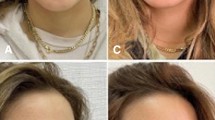Abstract
Background
Although the fat-pad-sliding method reported by Loeb and the “arcus marginalis release with preservation of orbital fat” method reported by Hamra are useful techniques for correcting tear trough deformity in the Asian population, including Japanese patients, occasional cases of tear-trough deformity have persisted even after surgery. To solve this problem, the authors developed a novel orbicularis oculi muscle overlap method, which has enabled them to obtain good results.
Methods
The orbicularis oculi muscle overlap method was performed for 10 patients (9 women and 1 man) with prominent tear-trough deformity. The average of these patients was 52 years (range, 34–72 years). The origin of the orbicularis oculi muscle was elevated at its adherence to the maxillary bone, and the innermost portion of the origin of the orbicularis oculi muscle was excised by a width of 6 to 7 mm to reduce the muscle tension. This muscle flap was overlapped relative to the orbital fat, which was repositioned over the orbital rim and sutured in place.
Results
Tear-trough deformity improved in all cases, and the patients were highly satisfied with their flat lower eyelids.
Conclusion
The orbicularis oculi muscle overlap method is effective for thin eyelids with prominent tear-trough deformity.
Level of Evidence V
This journal requires that authors assign a level of evidence to each article. For a full description of these Evidence-Based Medicine ratings, please refer to the Table of Contents or the online Instructions to Authors www.springer.com/00266.





Similar content being viewed by others
References
Loeb R (1981) Fat pad sliding and fat grafting for leveling lid depressions. Clin Plast Surg 8:757–776
Hamra ST (1995) Arcus marginalis release and orbital fat preservation in midface rejuvenation. Plast Reconstr Surg 96:354–362
Hamra ST (1998) The zygorbicular dissection in composite rhytidectomy: an ideal midface plane. Plast Reconstr Surg 102:1646–1657
Goldberg RA (2000) Transconjunctival orbital fat repositioning: transposition of orbital fat pedicles into a subperiosteal pocket. Plast Reconstr Surg 105:743–748
Barton FE Jr, Ha R, Awada M (2004) Fat extrusion and septal reset in patients with the tear trough triad: a critical appraisal. Plast Reconstr Surg 113:2115–2121 discussion 2122–2113
Liao SL, Wei YH (2011) Fat repositioning via supraperiosteal dissection with internal fization for tear trough deformity in an Asian population. Graefes Arch Clin Exp Ophthalmol 249:1735–1741
Flowers RS (1993) Tear trough implants for correction of tear trough deformity. Clin Plast Surg 20:403–415
Loeb R (1993) Naso-jugal groove leveling with fat tissue. Clin Plast Surg 20:393–400 discussion 401
Haddock NT, Saadeh PB, Boutros S et al (2009) The tear trough and lid/cheek junction: anatomy and implications for surgical correction. Plast Reconstr Surg 123:1332–1340
Coleman SR (1994) The technique of periorbital lipoinfiltration. Oper Tech Plast Reconstr Surg 1:20–26
Koh KS, Choi JW, Ishii CH (2012) Asian facial cosmetic surgery. In: Neligan PC, Warren RJ (eds) Plastic surgery, vol 2, 3rd edn. Elsevier Saunders, Philadelphia, pp 163–183
Conflict of interest
The authors declare that they have no conflict of interest to disclose
Author information
Authors and Affiliations
Corresponding author
Rights and permissions
About this article
Cite this article
Komuro, Y., Koizumi, T. & Matsumoto, S. Use of a Novel Orbicularis Oculi Muscle Overlap Method for Correction of Tear-Trough Deformity. Aesth Plast Surg 38, 648–652 (2014). https://doi.org/10.1007/s00266-014-0363-x
Received:
Accepted:
Published:
Issue Date:
DOI: https://doi.org/10.1007/s00266-014-0363-x




